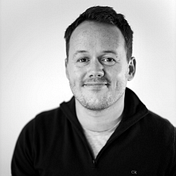The Unparalleled Genius of John von Neumann
Known now as “the last representative of the great mathematicians”, von Neumann’s genius was legendary even in his own lifetime. The sheer breadth of stories and anecdotes about his brilliance, from Nobel Prize-winning physicists to world-class mathematicians abound.
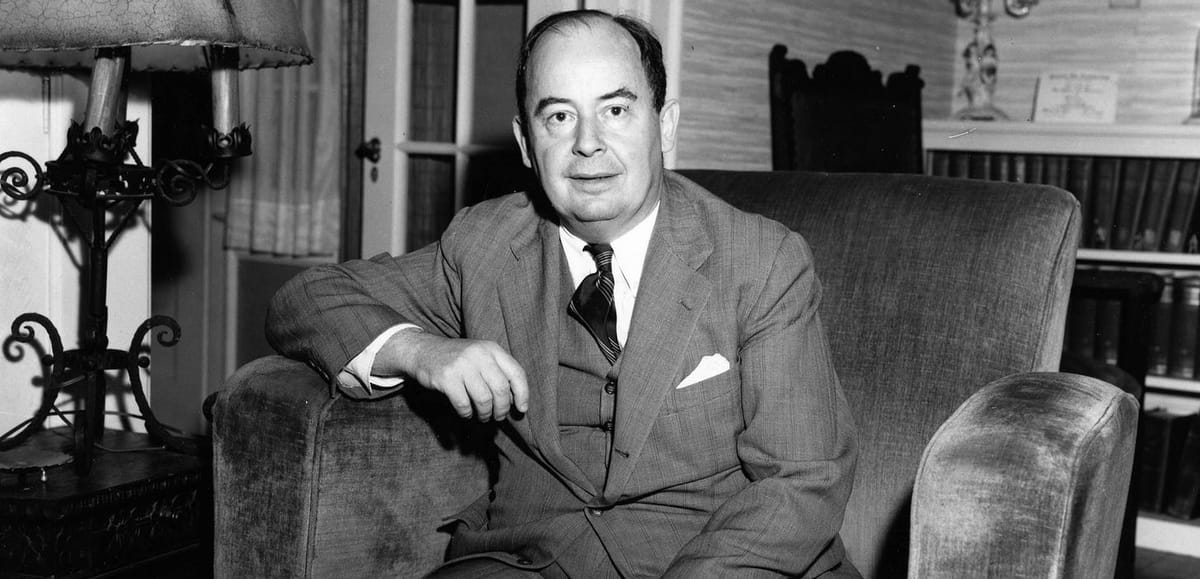
“Most mathematicians prove what they can, von Neumann proves what he wants”
It is indeed supremely difficult to effectively refute the claim that John von Neumann is likely the most intelligent person who has ever lived. By the time of his death in 1957 at the modest age of 53, the Hungarian polymath had not only revolutionized several subfields of mathematics and physics but also made foundational contributions to pure economics and statistics and taken key parts in the invention of the atomic bomb, nuclear energy and digital computing.
Known now as “the last representative of the great mathematicians”, von Neumann’s genius was legendary even in his own lifetime. The sheer breadth of stories and anecdotes about his brilliance, from Nobel Prize-winning physicists to world-class mathematicians abound:
”You know, Herb, Johnny can do calculations in his head ten times as fast as I can. And I can do them ten times as fast as you can, so you can see how impressive Johnny is” — Enrico Fermi (Nobel Prize in Physics, 1938)
“One had the impression of a perfect instrument whose gears were machined to mesh accurately to a thousandth of an inch.” — Eugene Wigner (Nobel Prize in Physics, 1963)
“I have sometimes wondered whether a brain like von Neumann’s does not indicate a species superior to that of man” — Hans Bethe (Nobel Prize in Physics, 1967)
And indeed, von Neumann both worked alongside and collaborated with some of the foremost figures of twentieth century science. He went to high school with Eugene Wigner, collaborated with Hermann Weyl at ETH, attended lectures by Albert Einstein in Berlin, worked under David Hilbert at Göttingen, with Alan Turing and Oskar Morgenstern in Princeton, with Niels Bohr in Copenhagen and was close with both Richard Feynman and J. Robert Oppenheimer at Los Alamos.
An émigré to America in 1933, von Neumann’s life was one famously dedicated to cognitive and creative pursuits, but also the enjoyments of life. Twice married and wealthy, he loved expensive clothes, hard liquor, fast cars and dirty jokes, according to his friend Stanisław Ulam. Almost involuntarily, his posthumous biographer Norman Macrae recounts, people took a liking to von Neumann, even those who disagreed with his conservative politics (Regis, 1992).
This essay aims to highlight some of the unbelievable feats of “Johnny” von Neumann’s mind.
Early years (1903–1921)
Neumann János Lajos (John Louis Neumann in English) was born (some say “arrived”) on December 28th 1903 in Budapest, Hungary. Born to wealthy non-observant Jewish bankers, his upbringing can be described as privileged. His father held a doctorate in law, and he grew up in an 18-room apartment on the top floor above the Kann-Heller offices at 62 Bajcsy-Zsilinszky Street in Budapest (Macrae, 1992).
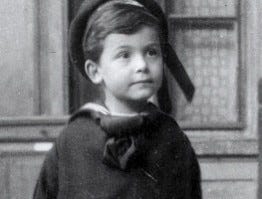
Child Prodigy
“Johnny” von Neumann was a child prodigy. Even from a young age, there were strange stories of little John Louis’ abilities: dividing two eight-digit numbers in his head and conversing in Ancient Greek at age six (Henderson, 2007), proficient in calculus at age eight (Nasar, 1998) and reading Emile Borel’s Théorie des Fonctions (“On some points in the theory of functions” ) at age twelve (Leonard, 2010). Reportedly, von Neumann possessed an eidetic memory, and so was able to recall complete novels and pages of the phone directory on command. This enabled him to accumulate an almost encyclopedic knowledge of what ever he read, such as the history of the Peloponnesian Wars, the Trial Joan of Arc and Byzantine history (Leonard, 2010). A Princeton professor of the latter topic once stated that by the time he was in his thirties, Johnny had greater expertise in Byzantine history than he did (Blair, 1957).
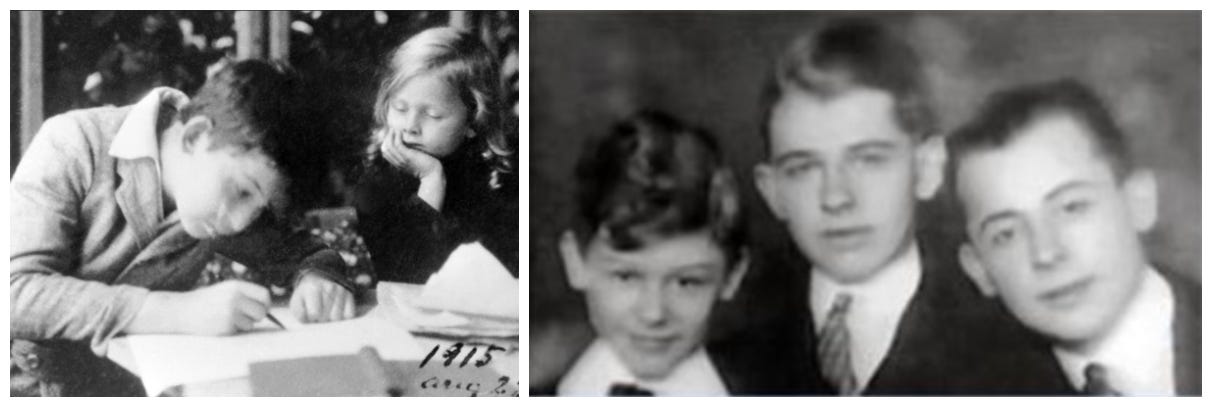
"One of his remarkable abilities was his power of absolute recall. As far as I could tell, von Neumann was able on once reading a book or article to quote it back verbatim; moreover, he could do it years later without hesitation. He could also translate it at no diminution in speed from its original language into English. On one occasion I tested his ability by asking him to tell me how A Tale of Two Cities started. Whereupon, without any pause, he immediately began to recite the first chapter and continued until asked to stop after about ten or fifteen minutes."
— Excerpt, The Computer from Pascal to von Neumann by Herman Goldstein (1980)
An unconventional parent, von Neumann’s father Max would reportedly bring his workaday banking decisions home to the family and ask his children how they would have reacted to particular investment possibilities and balance-sheet risks (Macrae, 1992). He was home-schooled until 1914, as was the custom in Hungary at the time. Starting at the age of 11, he was enrolled in the German-speaking Lutheran Gymnasium in Budapest. He would attend the high school until 1921, famously overlapping the high school years of three other “Martians” of Hungary:
- Leo Szilard (att. 1908–16 at Real Gymnasium), the physicist who conceived of the nuclear chain reaction and in late 1939 wrote the famous Einstein-Szilard letter for Franklin D. Roosevelt that resulted in the formation of the Manhattan Project that built the first atomic bomb
- Eugene Wigner (att. 1913–21 at Lutheran Gymnasium), the 1963 Nobel Prize laureate in Physics who worked on the Manhattan Project, including the theory of the atomic nucleus, elementary particles and Wigner’s Theorem in quantum mechanics
- Edward Teller (att. 1918–26 at Minta School), the “father of the hydrogen bomb”, an early member of the Manhattan Project and contributor to nuclear and molecular physics, spectroscopy and surface physics
Although all of similar ages and interests, as Macrae (1992) writes:
"The four Budapesters were as different as four men from similar backgrounds could be. They resembled one another only in the power of the intellects and in the nature of their professional careers. Wigner [...] is shy, painfully modest, quiet. Teller, after a lifetime of successful controversy, is emotional, extroverted and not one to hide his candle. Szilard was passionate, oblique, engagé, and infuriating. Johnny [...] was none of these. Johnny's most usual motivation was to try to make the next minute the most productive one for whatever intellectual business he had in mind."
— Excerpt, John von Neumann by Norman Macrae (1992)
Yet still, the four would work together off and on as they all emigrated to America and got involved in the Manhattan Project.
By the time von Neumann enrolled in university in 1921, he had already written a paper with one of his tutors, Mikhail Fekete on “A generalization of Fejér’s theorem on the location of the roots of a certain kind of polynomial” (Ulam, 1958). Fekete had along with Laszló Rátz reportedly taken a notice to von Neumann and begun tutoring him in university-level mathematics. According to Ulam, even at the age of 18, von Neumann was already recognized as a full-fledged mathematician. Of an early set theory paper written by a 16 year old von Neumann, Abraham Fraenkel (of Zermelo-Fraenkel set theory fame) himself later stated (Ulam, 1958):
Letter from Abraham Fraenkel to Stanislaw Ulam
Around 1922-23, being then professor at Marburg University, I received from Professor Erhard Schmidt, Berlin [...] a long manuscript of an author unknown to me, Johann von Neumann, with the title Die Axiomatisierung der Mengerlehre, this being his eventual doctor dissertation which appeared in the Zeitschrift only in 1928 [...] I asked to express my view since it seemed incomprehensible. I don't maintain that I understood anything, but enough to see that this was an outstanding work, and to recognize ex ungue leonem [the claws of the lion]. While answering in this sense, I invited the young scholar to visit me in Marburg, and discussed things with him, strongly advising him to prepare the ground for the understanding of so technical an essay by a more informal essay which could stress the new access to the problem and its fundamental consequences. He wrote such an essay under the title Eine Axiomatisierung der Mengerlehre and I published it in 1925.
In University (1921–1926)
As Macrae (1992) writes, there was never much doubt that Johnny would one day be attending university. Johnny’s father, Max, initially wanted him to follow in his footsteps and become a well-paid financier, worrying about the financial stability of a career in mathematics. However, with the help of the encouragement from Hungarian mathematicians such as Lipót Fejér and Rudolf Ortvay, his father eventually acquiesced and decided to let von Neumann pursue his passions, financing his studies abroad.
Johnny, apparently in agreement with his father, decided initially to pursue a career in chemical engineering. As he didn’t have any knowledge of chemistry, it was arranged that he could take a two-year non-degree course in chemistry at the University of Berlin. He did, from 1921 to 1923, afterwards sitting for and passing the entrance exam to the prestigious ETH Zurich. Still interested in pursuing mathematics, he also simultaneously entered University Pázmány Péter (now Eötvös Loránd University) in Budapest as a Ph.D. candidate in mathematics. His Ph.D. thesis, officially written under the supervision of Fejér, regarded the axiomatization of Cantor’s set theory. As he was officially in Berlin studying chemistry, he completed his Ph.D. largely in absentia, only appearing at the University in Budapest at the end of each term for exams. While in Berlin, he collaborated with Erhard Schmidt on set theory and also attended courses in physics, including statistical mechanics taught by Albert Einstein. At ETH, starting in 1923, he continued both his studies in chemistry and his research in mathematics.
“Evidently, a Ph.D. thesis and examinations did not constitute an appreciable effort” — Eugene Wigner
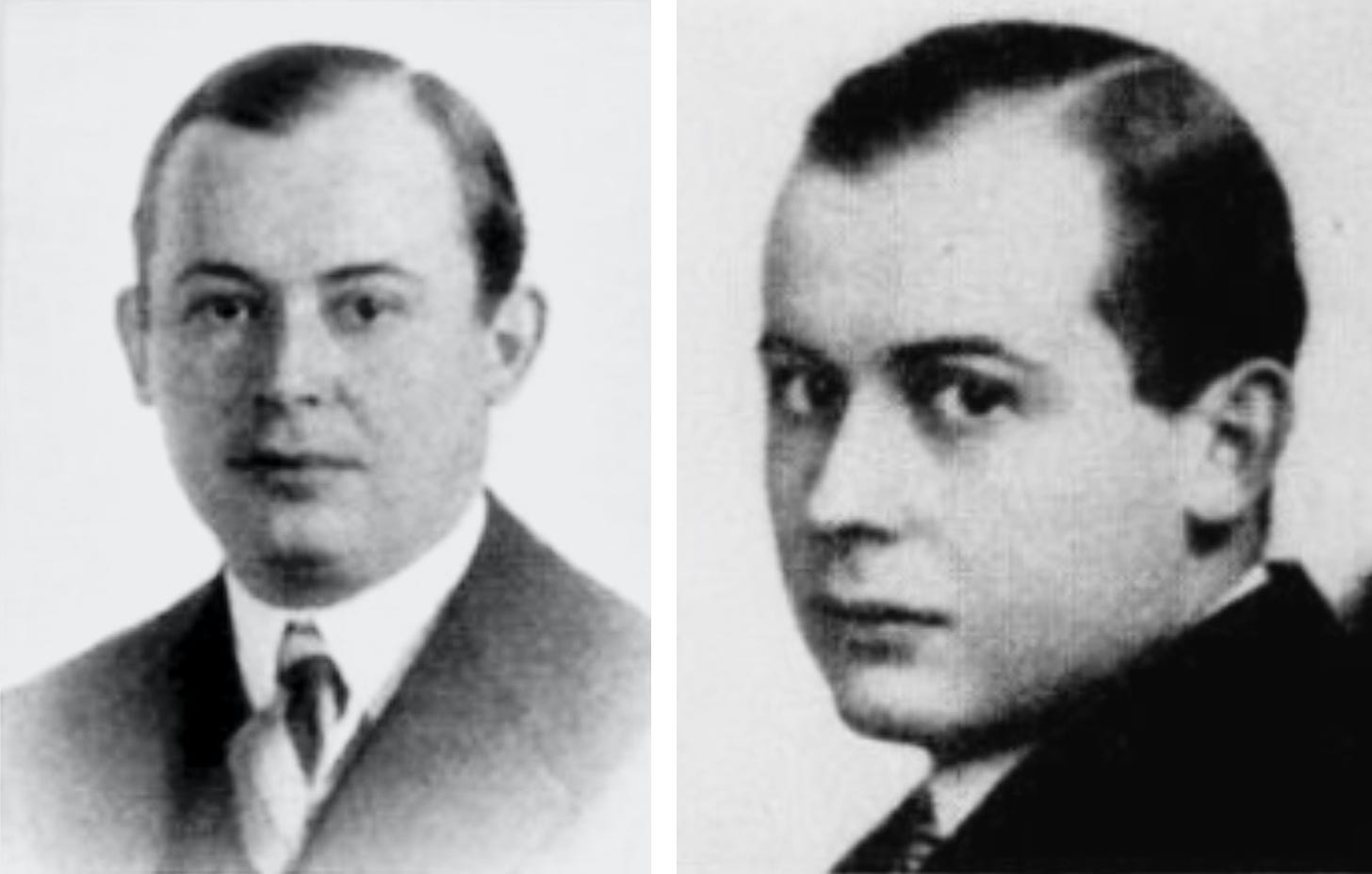
In mathematics, he first studied Hilbert’s theory of consistency with German mathematician Hermann Weyl. He eventually graduated both as a chemical engineer from ETH and with Ph.D. in mathematics, summa cum laude from the University of Budapest in 1926 at 24 years old.
“There was a seminar for advanced students in Zürich that I was teaching and von Neumann was in the class. I came to a certain theorem, and I said it is not proved and it may be difficult. von Neumann didn’t say anything but after five minutes he raised his hand. When I called on him he went to the blackboard and proceeded to write down the proof. After that I was afraid of von Neumann” — George Pólya
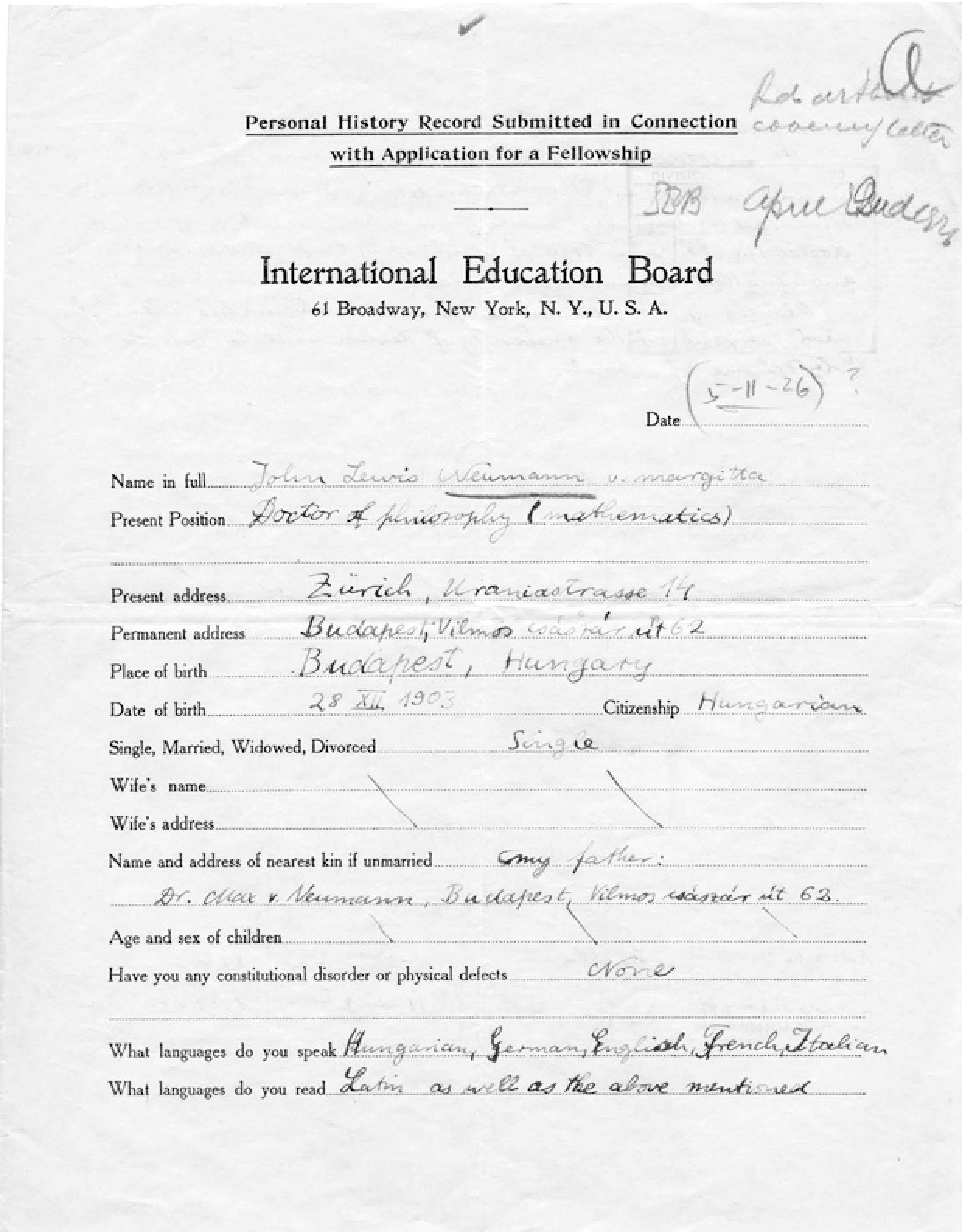
His application to the Rockefeller-financed International Education Board (above) for a six-month fellowship to continue his research at the University of Göttingen mentions Hungarian, German, English, French and Italian as spoken languages, and was accompanied by letters of recommendation from Richard Courant, Hermann Weyl and David Hilbert, three of the world’s foremost mathematicians at the time (Leonard, 2010).
In Göttingen (1926–1930)
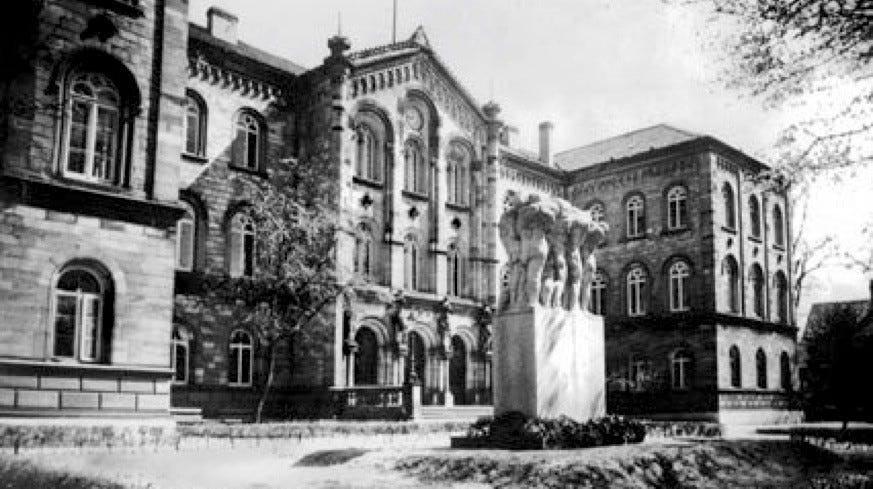
Johnny traveled to Göttingen in the fall of 1926 to continue his work in mathematics under David Hilbert, likely the world’s foremost mathematician of that time. Reportedly, according to Leonard (2010), von Neumann was initially attracted to Hilbert’s stance in the debate over so-called metamathematics, also known as formalism and that this is what drove him to study under Hilbert. In particular, in his fellowship application, he wrote of his wish to conduct (Leonard, 2010)
"Research over the bases of mathematics and of the general theory of sets, especially Hilbert's theory of uncontradictoriness [...], [investigations which] have the purpose of clearing up the nature of antinomies of the general theory of sets, and thereby to securely establish the classical foundations of mathematics. Such research render it possible to explain critically the doubts which have arisen in mathematics"
Very much both in the vein and language of Hilbert, von Neumann was likely referring to the fundamental questions posed by Georg Cantor regarding the nature of infinite sets starting in the 1880s. von Neumann, along with Wilhelm Ackermann and Paul Bernays would eventually become Hilbert’s key assistants in the elaboration of his Entscheidungsproblem (“decision problem”) initiated in 1918. By the time he arrived in Göttingen, von Neumann was already well acquainted with the topic, in addition to his Ph.D. dissertation having already published two related papers while at ETH.
Set theory
John von Neumann wrote a cluster of papers on set theory and logic while in his twenties:
- von Neumann (1923). His first set theory paper is entitled Zur Einführung der transfiniten Zahlen (“On the introduction of transfinite numbers”) and regards Cantor’s 1897 definition of ordinal numbers as order types of well-ordered sets. In the paper, von Neumann introduces a new theory of ordinal numbers, which regards an ordinal as the set of the preceding ordinals (Van Heijenoort, 1970).
- von Neumann (1925). His second set theory paper is entitled Eine Axiomatisierung der Mengenlehre (“An axiomatization of set theory”). It is the first paper that introduces what would later be known as the von Neumann-Bernays-Gödel set theory (NBG) and includes the first introduction of the concept of a class, defined using the primitive notions of functions and arguments. In the paper, von Neumann takes a stance in the foundations of mathematics debate, objecting to Brouwer and Weyl’s willingness to ‘sacrifice much of mathematics and set theory’, and logicists’ ‘attempts to build mathematics on the axiom of reducibility’. Instead, he argued for the axiomatic approach of Zermelo and Fraenkel, which, in von Neumann’s view, replaced vagueness with rigor (Leonard, 2010).
- von Neumann (1926). His third paper Az általános halmazelmélet axiomatikus felépitése, his doctoral dissertation, which contains the main points which would be published in German for the first time in his fifth paper.
- von Neumann (1928). In his fourth set theory paper, entitled Die Axiomatisierung der Mengenlehre (“The Axiomatization of Set Theory”), von Neumann formally lays out his own axiomatic system. With its single page of axioms, it was the most succinct set theory axioms developed at the time, and formed the basis for the system later developed by Gödel and Berneys.
- von Neumann (1928). His fifth paper on set theory, “Über die Definition durch transfinite Induktion und verwandte Fragen der allgemeinen Mengenlehre” (“On the Definition by Transfinite Induction and related questions of General Set Theory”) proves the possibility of definition by transfinite induction. That is, in the paper von Neumann demonstrates the significance of axioms for the elimination of the paradoxes of set theory, proving that a set does not lead to contradictions if and only if its cardinality is not the same as the cardinality of all sets, which implies the axiom of choice (Leonard, 2010).
- von Neumann (1929). In his sixth set theory paper, Über eine Widerspruchsfreiheitsfrage in der axiomatischen Mengenlehre, von Neumann discusses the questions of relative consistency in set theory (Van Heijenoort, 1970).
Summarized, von Neumann’s main contribution to set theory is what would become the von Neumann-Bernays-Gödel set theory (NBG), an axiomatic set theory that is considered a conservative extension of the accepted Zermelo-Fraenkel set theory (ZFC). It introduced the notion of class (a collection of sets defined by a formula whose quantifiers range only over sets) and defines classes that are larger than sets, such as the class of all sets and the class of all ordinal numbers.
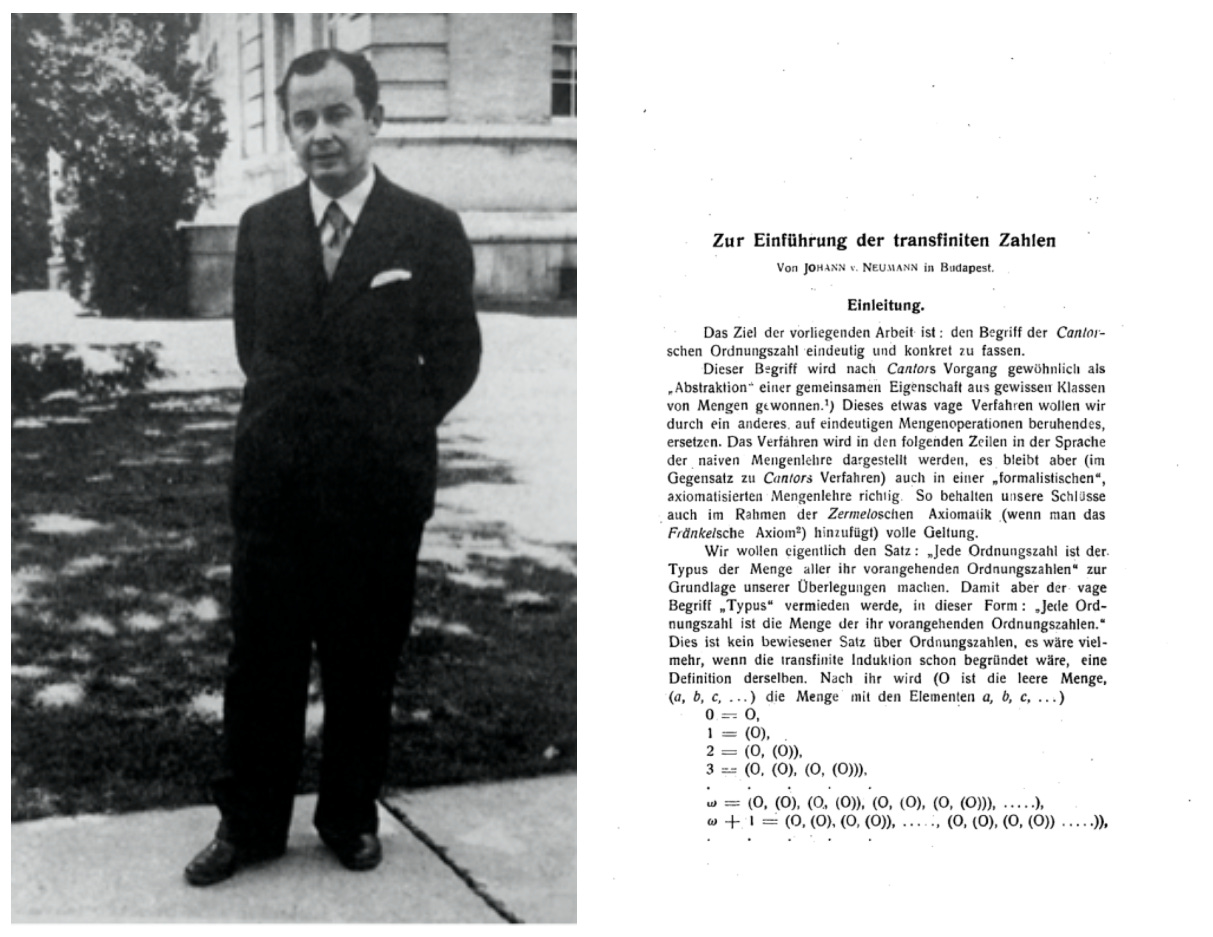
Inspired by the works of Georg Cantor, Ernst Zermelo’s 1908 axioms for set theory and the 1922 critiques of Zermelo’s set theory by Fraenkel and Skolem, von Neumann’s work provided solutions to some of the problems of Zermelo set theory, leading to the eventual development of Zermelo-Fraenkel set theory (ZFC). The problems he helped resolve include:
- The problem of developing Cantor’s theory of ordinal numbers in Zermelo set theory. von Neumann redefined ordinals using sets that are well-ordered using the so-called ∈-relation.
- The problem of finding a criterion identifying classes that are too large to be sets. von Neumann introduced the criterion that a class is too large to be a set if and only if it can be mapped onto the class of all sets.
- Zermelo’s somewhat imprecise concept of a ‘definite propositional function’ in his axiom of separation. von Neumann formalized the concept with his functions, whose construction requires only finitely many axioms.
- The problem of Zermelo’s foundations of the empty set and an infinite set, and iterating the axioms of pairing, union, power set, separation and choice to generate new sets. Fraenkel introduced an axiom to exclude sets. von Neumann revised Fraenkel’s formulation in his axiom of regularity to exclude non-well-founded sets.
Of course, following the critiques and further revisions of Zermelo’s set theory by Fraenkel, Skolem, Hilbert and von Neumann, a young mathematician by the name of Kurt Gödel in 1930 published a paper which would effectively end von Neumann’s efforts in formalist set theory, and indeed Hilbert’s formalist program altogether, his theorem of incompleteness. von Neumann happened to be in the audience when Gödel first presented it:
"At a mathematical conference preceding Hilbert's address, a quiet, obscure young man, Kurt Gödel, only a year beyond his PhD, announced a result which would forever change the foundations of mathematics. He formalized the liar paradox, "This statement is false" to prove roughly that for any effectively axiomatized consistent extension T of number theory (Peano arithmetic) there is a sentence σ which asserts its own unprovability in T.
John von Neumann, who was in the audience immediately understood the importance of Gödel's incompleteness theorem. He was at the conference representing Hilbert's proof theory program and recognized that Hilbert's program was over.
In the next few weeks von Neumann realized that by arithmetizing the proof of Gödel's first theorem, one could prove an even better one, that no such formal system T could prove its own consistency. A few weeks later he brought his proof to Gödel, who thanked him and informed him politely that he had already submitted the second incompleteness theorem for publication."
— Excerpt, Computability. Turing, Gödel, Church and Beyond by Copeland et al. (2015)
One of Gödel’s lifelong supporters, von Neumann later stated that
“Gödel is absolutely irreplaceable. In a class by himself.”
By the end of 1927, von Neumann had published twelve major papers in mathematics. His habilitation (qualification to conduct independent university teaching) was completed in December of 1927, and he began lecturing as a Privatdozent at the University of Berlin in 1928 at the age of 25, the youngest Privatdozent ever elected in the university’s history in any subject.
"By the middle of 1927 it was clearly desirable for the young eagle Johnny to soar from Hilbert's nest. Johnny had spent his undergraduate years explaining what Hilbert had got magnificently right but was now into his postgraduate years where had to explain what Hilbert had got wrong"
— Excerpt, John von Neumann by Norman Macrae (1992)
Game Theory
Around the same time he was making contributions to set theory, von Neumann also proved a theorem known as the minimax theorem for zero-sum games, which would later lay the foundation for the new field of game theory as a mathematical discipline. The minimax theorem may be summarized as follows:
The Minimax Theorem (von Neumann, 1928). The minimax theorem provides the conditions that guarantee that the max-min inequality is also an equality, i.e. that every finite, zero-sum, two-person game has optimal mixed strategies.
The proof was published in Zur Theorie der Gesellschaftsspiele (“On the Theory of Games of Strategy”) in 1928. In collaboration with economist Oskar Morgenstern, von Neumann later published the definitive book on such cooperative, zero-sum games, Theory of Games and Economic Behavior (1944).

By the end of 1929, von Neumann’s number of published major papers had risen to 32, averaging almost one major paper per month. In 1929 he briefly became a Privatdozent at the University of Hamburg, where he found the prospects of becoming a professor to be better.
Quantum Mechanics
In a shortlist von Neumann himself submitted to the National Academy of Sciences later in his life, he listed his work on quantum mechanics in Göttingen (1926) and Berlin (1927–29) as the “most essential”. The term quantum mechanics, largely devised by Göttingen’s own twenty-three year old wunderkind Werner Heisenberg the year before was still hotly debated, and in the same year von Neumann arrived, Erwin Schrödinger, then working from Switzerland, had rejected Heisenberg’s formulation as completely wrong (Macrae, 1992). As the story goes:
"In Johnny's early weeks at Göttingen in 1926, Heisenberg lectured on the difference between his and Schrödinger's theories. The aging Hilbert, professor of mathematics, asked his physics assistant, Lothar Nordheim, what on earth this young man Heisenberg was talking about. Nordheim sent to the professor a paper that Hilbert still did not understand. To quote Nordheim himself, as recorded in Heims's book: "When von Neumann saw this, he cast it in a few days into elegant axiomatic form, much to the liking of Hilbert." To Hilbert's delight, Johnny's mathematical exposition made much use of Hilbert's own concept of Hilbert space." - Excerpt, John von Neumann by Norman Macrae (1992)
Starting with the incident above, in the following years, von Neumann published a set of papers which would establish a rigorous mathematical framework for quantum mechanics, now known as the Dirac-von Neumann axioms. As Van Hove (1958) writes,
"By the time von Neumann started his investigations on the formal framework of quantum mechanics this theory was known in two different mathematical formulations: the "matrix mechanics" of Heisenberg, Born and Jordan, and the "wave mechanics" of Schrödinger. The mathematical equivalence of these formulations had been established by Schrödinger, and they had both been embedded as special cases in a general formalism, often called "transformation theory", developed by Dirac and Jordan.
This formalism, however, was rather clumsy and it was hampered by its reliance upon ill-defined mathematical objects, the famous delta-functions of Dirac and their derivatives. [..] [von Neumann] soon realized that a much more natural framework was provided by the abstract, axiomatic theory of Hilbert spaces and their linear operators."
— Excerpt, Von Neumann's Contributions to Quantum Theory by Léon Van Hove (1958)
In the period from 1927–31, von Neumann published five highly influential papers relating to quantum mechanics:
- von Neumann (1927). Mathematische Begründung der Quantenmechanik (“Mathematical Foundation of Quantum Mechanics”) in Nachrichten von der Gesellschaft der Wissenschaften zu Göttingen, Mathematisch-Physikalische Klasse pp. 1–57.
- von Neumann (1927). Wahrscheinlichkeitstheoretischer Aufbau der Quantenmechanik (“Probabilistic Theory of Quantum Mechanics”) in Nachrichten von der Gesellschaft der Wissenschaften zu Göttingen, Mathematisch-Physikalische Klasse pp. 245–272.
- von Neumann (1927). Thermodynamik quantenmechanischer Gesamtheiten (“Thermodynamics of Quantum Mechanical Quantities”) in Nachrichten von der Gesellschaft der Wissenschaften zu Göttingen, Mathematisch-Physikalische Klasse. pp. 273–291.
- von Neumann (1930). Allgemeine Eigenwerttheorie Hermitescher Funktionaloperatoren (“General Eigenvalue Theory of Hermitian Functional Operators”) in Mathematische Annalen 102 (1) pp 49–131.
- von Neumann (1931). Die Eindeutigkeit der Schrödingerschen Operatoren (“The uniqueness of Schrödinger operators”) in Mathematische Annalsen 104 pp 570–578.
His basic insight, which neither Heisenberg, Bohr or Schrödinger had, in the words of Paul Halmos was“that the geometry of the vectors in a Hilbert space have the same formal properties as the structure of the states of a quantum mechanical system” (Macrae, 1992). That is, von Neumann realized that the state of a quantum system could be represented by the point of a complex Hilbert space, that in general, could be infinite-dimensional even for a single particle. In such a formal view of quantum mechanics, observable quantities such as position or momentum are represented as linear operators acting on the Hilbert space associated with the quantum system (Macrae, 1992). The uncertainty principle, for instance, in von Neumann’s system is translated into the non-commutativity of two corresponding operators.
Summarized, von Neumann’s contributions to quantum mechanics can be said to broadly be two-fold, consisting of:
- The mathematical framework of quantum theory, where states of the physical system are described by Hilbert space vectors and measurable quantities (such as position, momentum and energy) by unbounded hermitian operators acting upon them; and
- The statistical aspects of quantum theory. In the course of his formulation of quantum mechanics in terms of vectors and operators in Hilbert spaces, von Neumann also gave the basic rule for how the theory should be understood statistically (Van Hove, 1958). That is, as the result of the measurement of a given physical quantity on a system in a given quantum state, its probability distribution should be expressed by means of a vector representing the state and the spectral resolution of the operator representing the physical quantity.
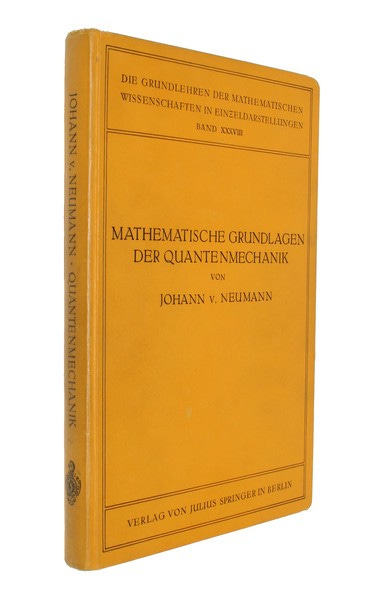
His work on quantum mechanics was eventually collected in the influential 1932 book Mathematische Grundlagen der Quantenmechanik (“Mathematical Foundations for Quantum Mechanics”), considered the first rigorous and complete mathematical formulation of quantum mechanics.
Quantum mechanics was very fortunate indeed to attract, in the very first years after its discovery in 1925, the interest of a mathematical genius of von Neumann’s stature. As a result, the mathematical framework of the theory was developed and the formal aspects of its entirely novel rules of interpretation were analysed by one single man in two years (1927–1929). — Van Hove (1958)
Operator theory
Following his work in set theory and quantum mechanics, while still in Berlin, von Neumann next turned his attention to algebra, in particular operator theory which concerns the study of linear operators on function spaces. The most trivial examples are the differential and integral operators we all remember from calculus. von Neumann introduced the study of rings of operators through his invention of what is now known as von Neumann algebras, defined as:
Definition of a von Neumann algebra. A von Neumann algebra is a *-algebra of bounded operators on a Hilbert space that is closed in the weak operator topology and contains the identify operator
The work was published in the paper Zur Algebra der Funktionaloperationen und Theorie der normalen Operatoren (“On the Algebra of Functional Operations and Theory of Normal Operators”) in 1930.
In America
John von Neumann first travelled to America while still a Privatdozent at the University of Hamburg in October 1929 when he was invited to lecture on quantum theory at Princeton University. The visit led to an invitation to return as a visiting professor, which he did in the years 1930–33. The same year this tenure finished, Adolf Hitler first came to power in Germany, leading von Neumann to abandon his academic posts in Europe altogether, stating about the Nazi regime that
“If these boys continue for two more years, they will ruin German science for a generation — at least”
By most accounts, of course, von Neumann’s prediction turned out true. The following year, when asked by the Nazi minister of education “How mathematics is going at Göttingen, now that it is free from the Jewish influence?” Hilbert is said to have replied:
“There is no mathematics in Göttingen anymore.”
At Princeton University (1930–1933)
The circumstances under which von Neumann (and a plethora of other first-rate mathematicians and physicists) would find themselves in Princeton, New Jersey in the mid-1930s is by now well known.
In the case of von Neumann in particular, he was recruited alongside his Lutheran high school contemporary Eugene Wigner by Princeton University professor Oswald Veblen, on a recommendation from Princeton, according to Wigner (Macrae, 1992) to:
"..invite not a single person but at least two, who already knew each other, who wouldn't suddenly feel put on an island where they had no intimate contact with anybody. Johnny's name was of course well known by that time the world over, so they decided to invite Johnny von Neumann. They looked: who wrote articles with John von Neumann? They found: Mr. Wigner. So they sent a telegram to me also."
— Excerpt, John von Neumann by Norman Macrae (1992)
And so von Neumann first came to Princeton in 1930 as a visiting professor. Regarding his work while there, von Neumann himself later in life especially highlighted his work on ergodic theory.
Ergodic Theory
“If von Neumann had never done anything else, they would have been sufficient to guarantee him mathematical immortality” — Paul Halmos (1958)
Ergodic theory is the branch of mathematics that studies the statistical properties of deterministic dynamical systems. Formally, ergodic theory is concerned with the states of dynamical systems with an invariant measure. Informally, think of how the planets move according to Newtonian mechanics in a solar system: the planets move but the rule governing the planets’ motion remains constant. In two papers published in 1932, von Neumann made foundational contributions to the theory of such systems, including the von Neumann’s mean ergodic theorem, considered the first rigorous mathematical basis for the statistical mechanics of liquids and gases. The two papers are titled Proof of the Quasi-ergodic Hypothesis (1932) and Physical Applications of the Ergodic Hypothesis (1932).
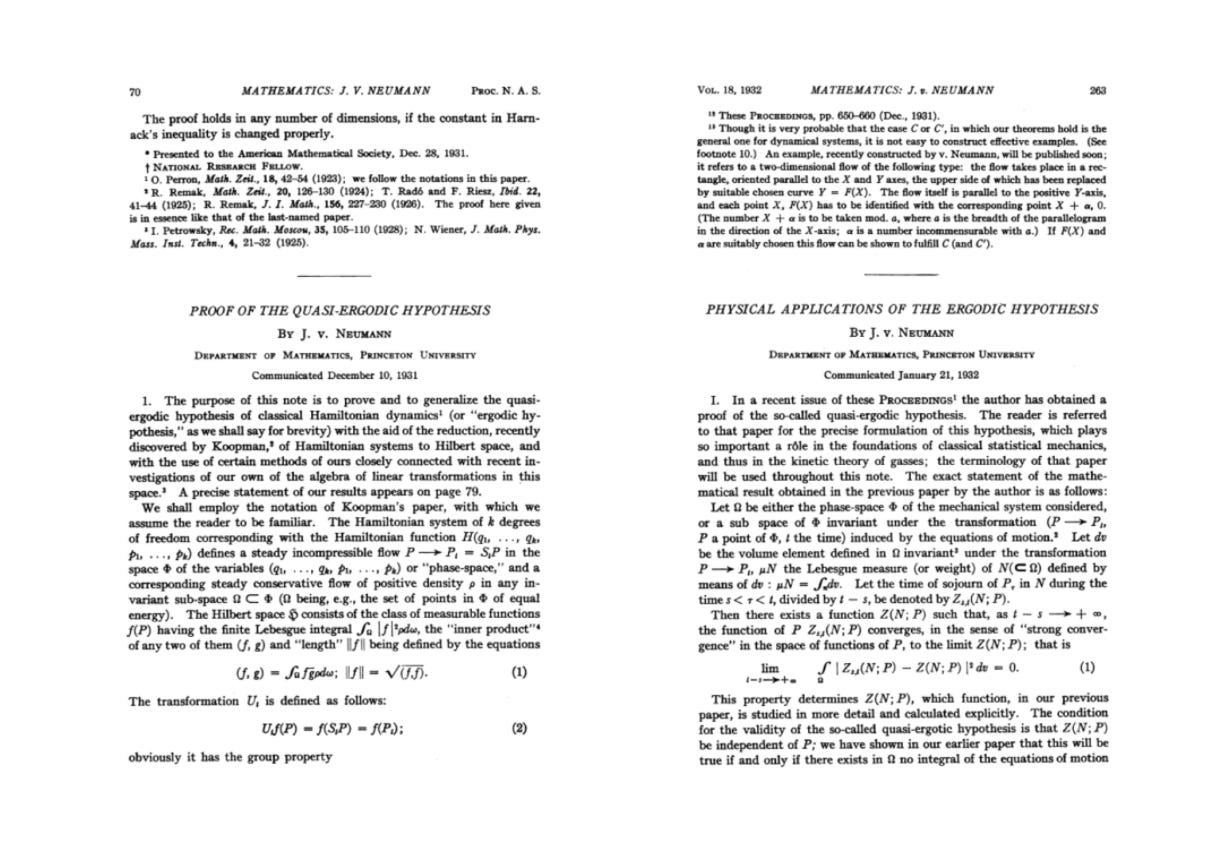
A subfield of measure theory, ergodic theory in other words concerns the behavior of dynamical systems which are allowed to run for a long time. von Neumann’s ergodic theorem is one of the two most important theorems in the field, the other being by Birkhoff (1931). According to Halmos (1958)
"The profound insight to be gained from [von Neumann's] paper is that the whole problem is essentially group-theoretic in character, and that, in particular, for the solvability of the problem of measure the ordinary algebraic concept of solvability of a group is relevant. Thus, according to von Neumann, it is the change of group that makes a difference, not the change of space; replacing the group of rigid motions by other perfectly reasonable groups we can produce unsolvable problems in R2 and solvable ones in R3."
— Excerpt, Von Neumann on Measure and Ergodic Theory by Paul R. Halmos (1958)
At the Institute for Advanced Study
Following his three-year stay as a visiting professor at Princeton in the period 1930–33, von Neumann was offered a lifetime professorship on the faculty of the Institute for Advanced Study (IAS) in 1933. He was 30 years old. The offer came after the the institute’s plan to appoint von Neumann’s former professor Hermann Weyl fell through (Macrae, 1992). Having only been founded three years prior, von Neumann became one of the IAS’ first six professors, the others being J. W. Alexander, Albert Einstein, Marston Morse, Oswald Veblen and eventually, Hermann Weyl.

When he joined in 1933, the Institute was still located in the math department of Princeton University’s Fine Hall. Founded in 1930 by Abraham Flexner and funded by philanthropy money from Louis Bamberger and Caroline Bamberger Fuld, the Institute for Advanced Study was and is still a university unlike any other. Inspired by Flexner’s experiences at Heidelberg University, All Souls College, Oxford and the Collège de France, the IAS has been described as:
“A first-rate research institution with no teachers, no students, no classes, but only researchers protected from the vicissitudes and pressures of the outside world.” — Sylvia Nasar
In 1939 moved to its own campus and common room Fuld Hall, the Institute for Advanced Study in a matter of a few years in the early 1930s effectively inherited the University of Göttingen’s throne as the foremost center of the mathematical universe. The dramatic and swift change has since become known as the “Great Purge of 1933”, as a number of top rate academics fled Europe, fearing for their safety. Among them, in addition to von Neumann and Wigner, of course was Einstein (1933), Max Born (1933), fellow Budapestians Leó Szilárd (1938) and Edward Teller (1933), as well as Edmund Landau (1927), James Franck (1933) and Richard Courant (1933), among others.
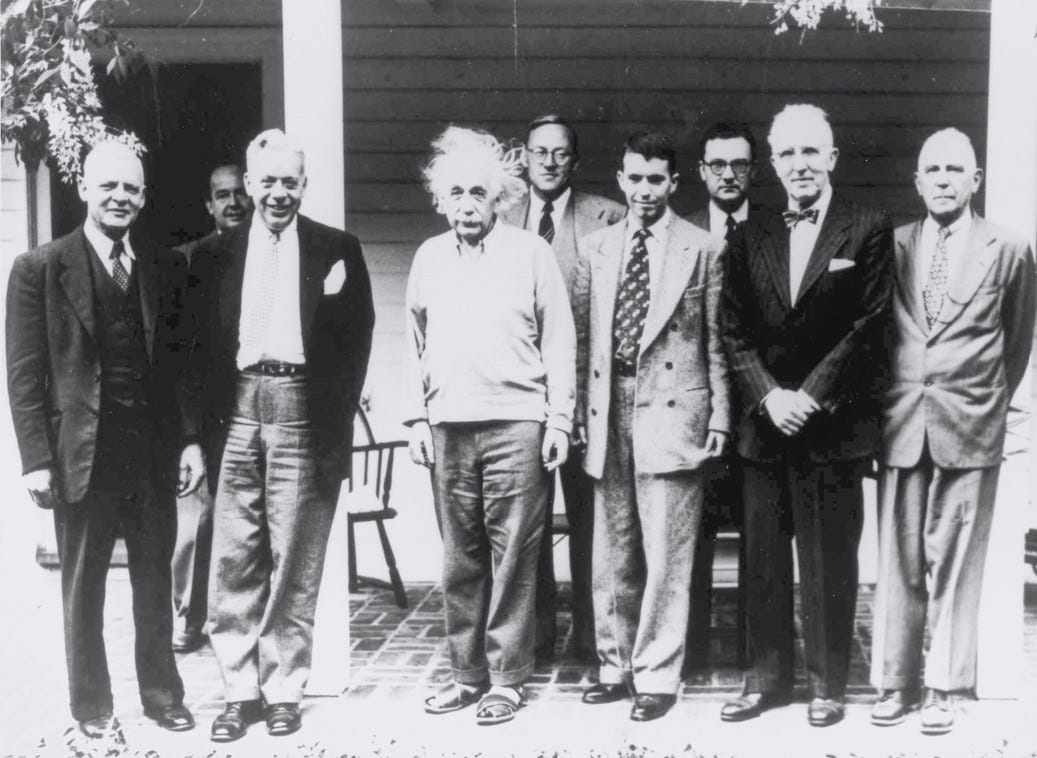
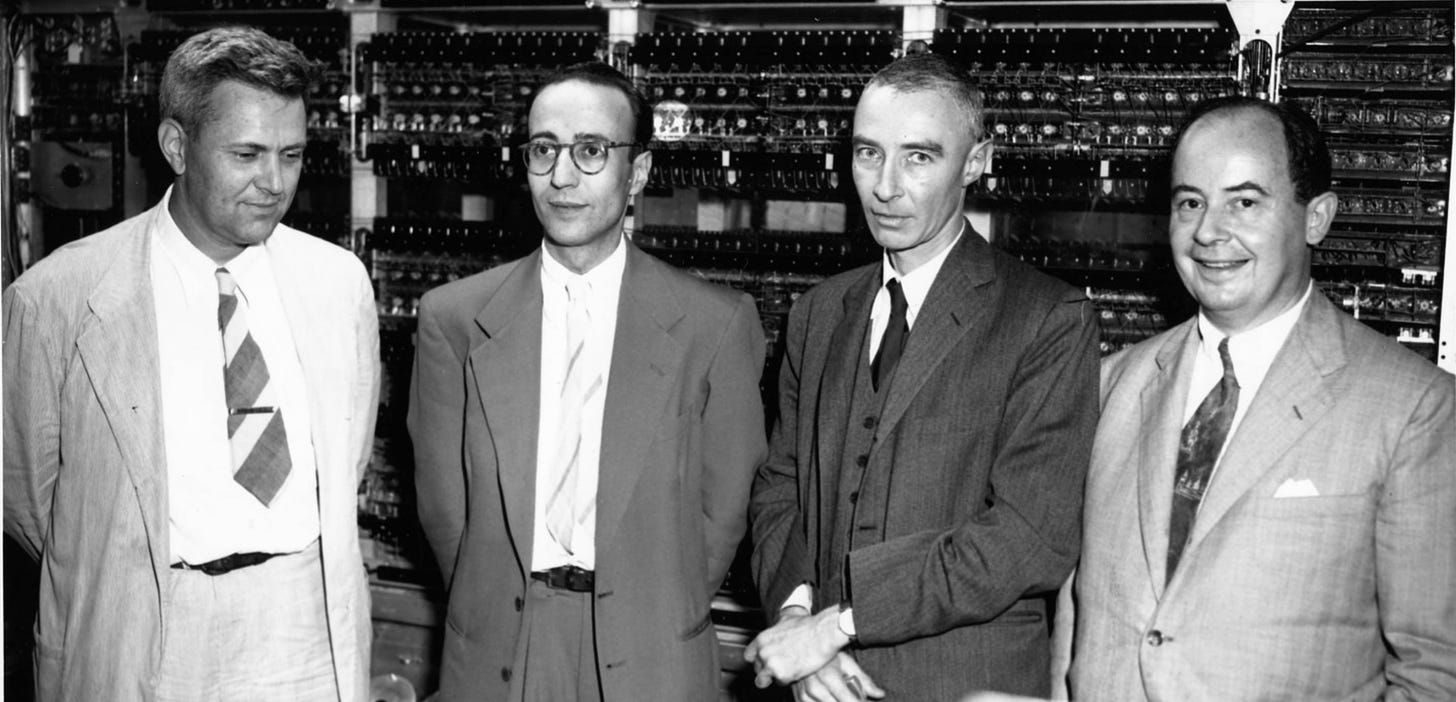
Geometry
While at the Institute for Advanced Study, von Neumann founded the field of continuous geometry, an analogue of complex projective geometry where instead of a dimension of a subspace being in a discrete set 0, 1, …, n, it can be an element of the unit interval [0,1].
A continuous geometry is a lattice L with the following properties:- L is modular- L is complete- The lattice operations satisfy a continuity property- Every element in L has a complement- L is irreducible, meaning the only elements with unique complements are 0 and 1.
As with his result in ergodic theory, von Neumann published two papers on continuous geometry, one proving its existence and discussing its properties, and one providing examples:
- von Neumann (1936). Continuous geometry. Proceedings of the National Academy of Sciences 22 (2) pp. 92–100.
- von Neumann (1936). Examples of continuous geometries. Proceedings of the National Academy of Sciences 22 (2) pp. 101–108;
The Manhattan Project (1937–45)
In addition to his academic pursuits, beginning in the mid to late 30s, von Neumann developed an expertise in the science of explosions, phenomena which are very hard to model mathematically. In particular, von Neumann became a leading authority on the mathematics of shaped charges, explosive charges shaped to focus the effect of the energy of an explosive.
By 1937, according to Macrae, von Neumann had decided for himself that war was clearly coming. Although obviously suited for advanced strategic and operations work, humbly he instead applied to become a lieutenant in the reserve of the ordnance department of the U.S.Army. As a member of the Officers’s Reserve Corps, this would mean that he could get trouble-free access to various sorts of explosion statistics, which he thought would be fascinating (Macrae, 1992).
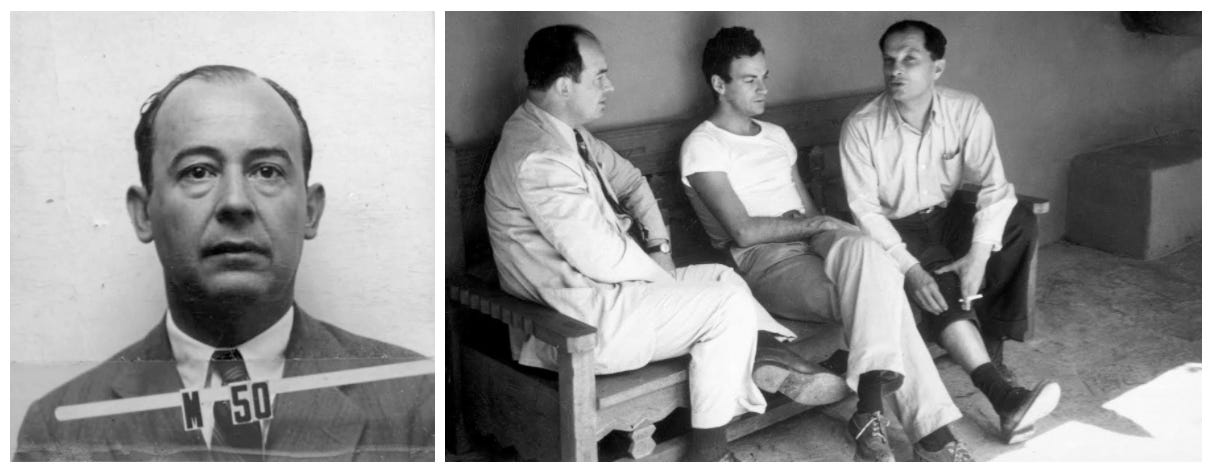
Needless to say, von Neumann‘s main contributions to the atomic bomb would not be as a lieutenant in the reserve of the ordnance department, but rather in the concept and design of the explosive lenses that were needed to compress the plutonium core of the Fat Man weapon that was later dropped on Nagasaki.
A member of the Manhattan Project in Los Alamos, New Mexico, von Neumann in 1944 showed that the pressure increase from explosion shock wave reflections from solid objects was greater than previously believed, depending on the angle of its incidence. The discovery led to the decision to detonate atomic bombs some kilometers above the target, rather than on impact (Macrae, 1992). von Neumann was present during the first Trinity test on July 16th, 1945 in the Nevada desert as the first atomic bomb test ever successfully detonated.
Work on Philosophy
Macrae (1992) makes the point that in addition to being one of the foremost mathematicians in his lifetime, in many ways, von Neumann should perhaps also be considered one of his era’s most important philosophers. Professor of philosophy John Dorling at the University of Amsterdam, in particular, highlights in particular von Neumann’s contributions to the philosophy of mathematics (including set theory, number theory and Hilbert spaces), physics (especially quantum theory), economics (game theory), biology (cellular automata), computers and artificial intelligence.
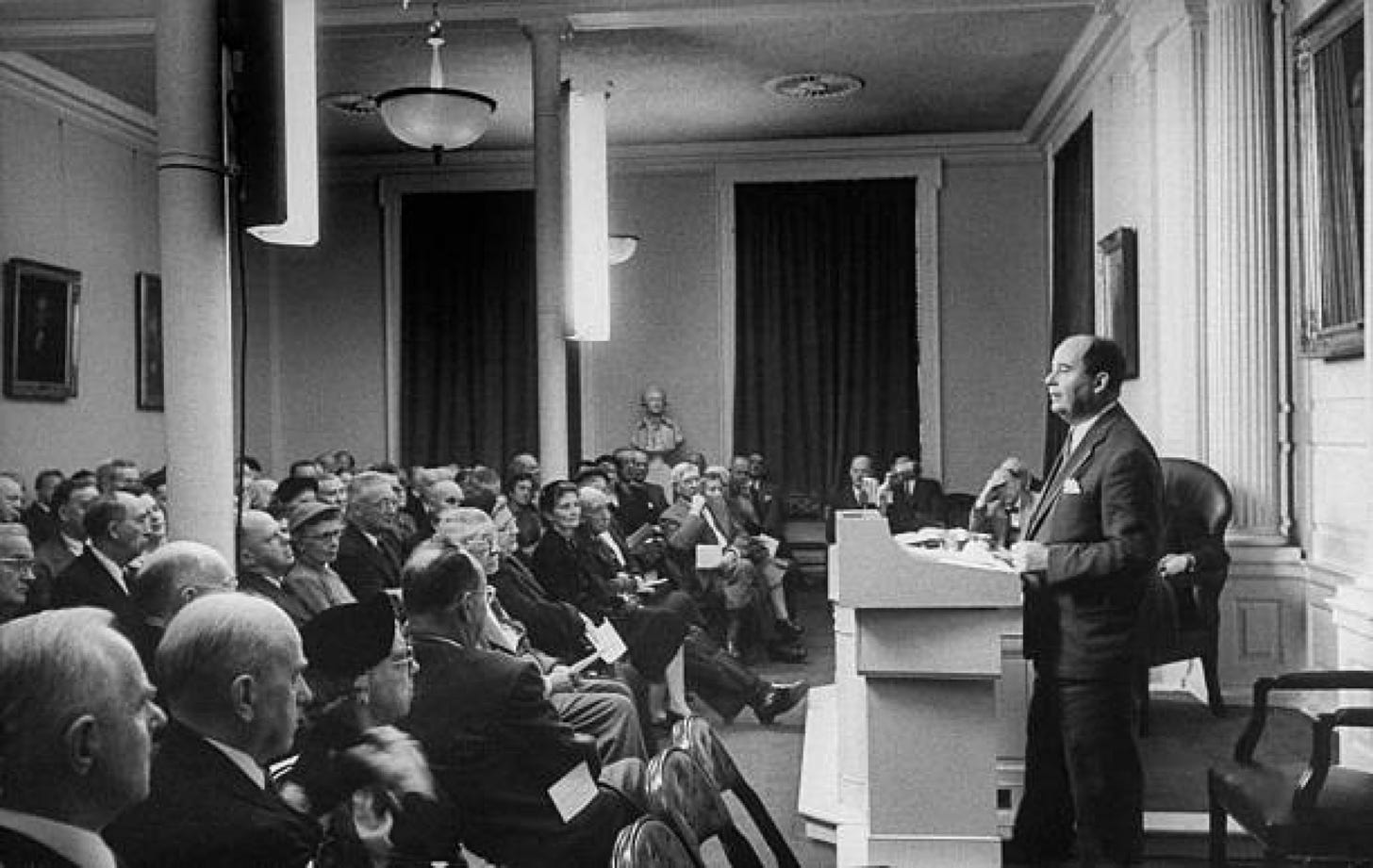
His work on the latter two, computers and artificial intelligence (AI) occurred first while he was in Princeton in the mid 1930s meeting with the then-24-year-old Alan Turing when he spent a year at the IAS in 1936–37. Turing began his career by working in the same field as von Neumann had — on set theory, logic and Hilbert’s Entscheidungsproblem. When he finished his Ph.D at Princeton in 1938, Turing had extended the work of von Neumann and Gödel and introduced ordinal logic and the notion of relative computing, augmenting his previously devised Turing machines with so-called oracle machines, allowing the study of problems that lay beyond the capabilities of Turing machines. Although inquired about by von Neumann for a position as a postdoctoral research assistant following his Ph.D., Turing declined and instead travelled back to England (Macrae, 1992).
Work on Computing
"After having been here for a month, I was talking to von Neumann about various kinds of inductive processes and evolutionary processes, and just as an aside he said, "Of course that's what Turing was talking about." And I said, "Who's Turing?". And he said, "Go look up Proceedings of the London Mathematical Society, 1937".
The fact that there is a universal machine to imitate all other machines ... was understood by von Neumann and few other people. And when he understood it, then he knew what we could do."
— Julian Bigelow"- Excerpt, Turing's Cathedral by George Dyson (2012)
Although Turing left, von Neumann continued thinking about computers throughout the end of the 30s and the war. Following his experiences working on the Manhattan Project, he was first drawn into the ENIAC project at the Moore School of Engineering at the University of Pennsylvania during the summer of 1944. Having observed the large amounts of calculation needed to predict blast radii, plan bomb paths and break encryption schemes, von Neumann early saw the need for substantial increases in computing power.
In 1945, von Neumann proposed a description for a computer architecture now known as the von Neumann architecture, which includes the basics of a modern electronic digital computer including:
- A processing unit that contains an arithmetic logic unit and processor registers;
- A control unit that contains an instruction register and a program counter
- A memory unit that can store data and instructions;
- External storage; and
- Input and output mechanisms;
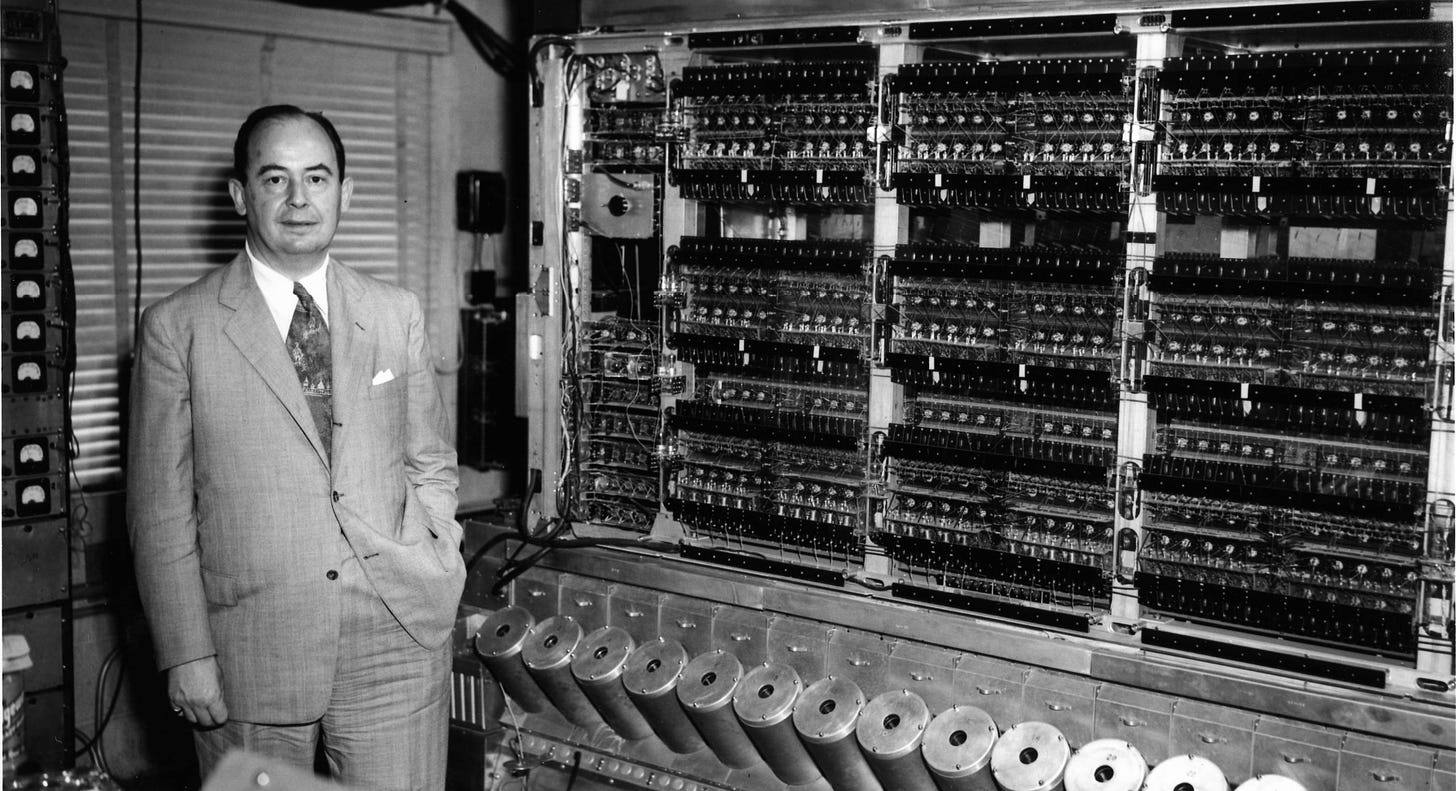
The same year, in software engineering, von Neumann invented the so-called merge sort algorithm which divides arrays in half before sorting them recursively and then merging them. von Neumann himself wrote the first 23 page sorting program for the EDVAC computer in ink. In addition, in a pioneering 1953 paper entitled Probabilistic Logics and the Synthesis of Reliable Organisms from Unrealiable Components, von Neumann was first to introduce stochastic computing, though the idea was so groundbreaking that it could not be implemented for another decade or so (Petrovik & Siljak, 1962). Related, von Neumann created the field of cellular automata through his rigorous mathematical treatment of the structure of self-replication, which preceded the discovery of the structure of DNA by several years.
Although influential in his own right, throughout his life, von Neumann made sure to acknowledge that the central concept of the modern computer was indeed Turing’s 1936 paper On Computable Numbers, with an Application to the Entscheidungsproblem (Fraenkel, 1972)
”von Neumann firmly emphasised to me, and to others I am sure, that the fundamental conception is owing to Turing — insofar as not anticipated by Babbage, Lovelace and others.” — Stanley Fraenkel (1972)
Consultancies
"The only part of your thinking we'd like to bid for systematically is that which you spend shaving: we'd like you to pass on to us any ideas that come to you while so engaged."
— Excerpt, Letter from the Head of the RAND Corporation to von Neumann (Poundstone, 1992)
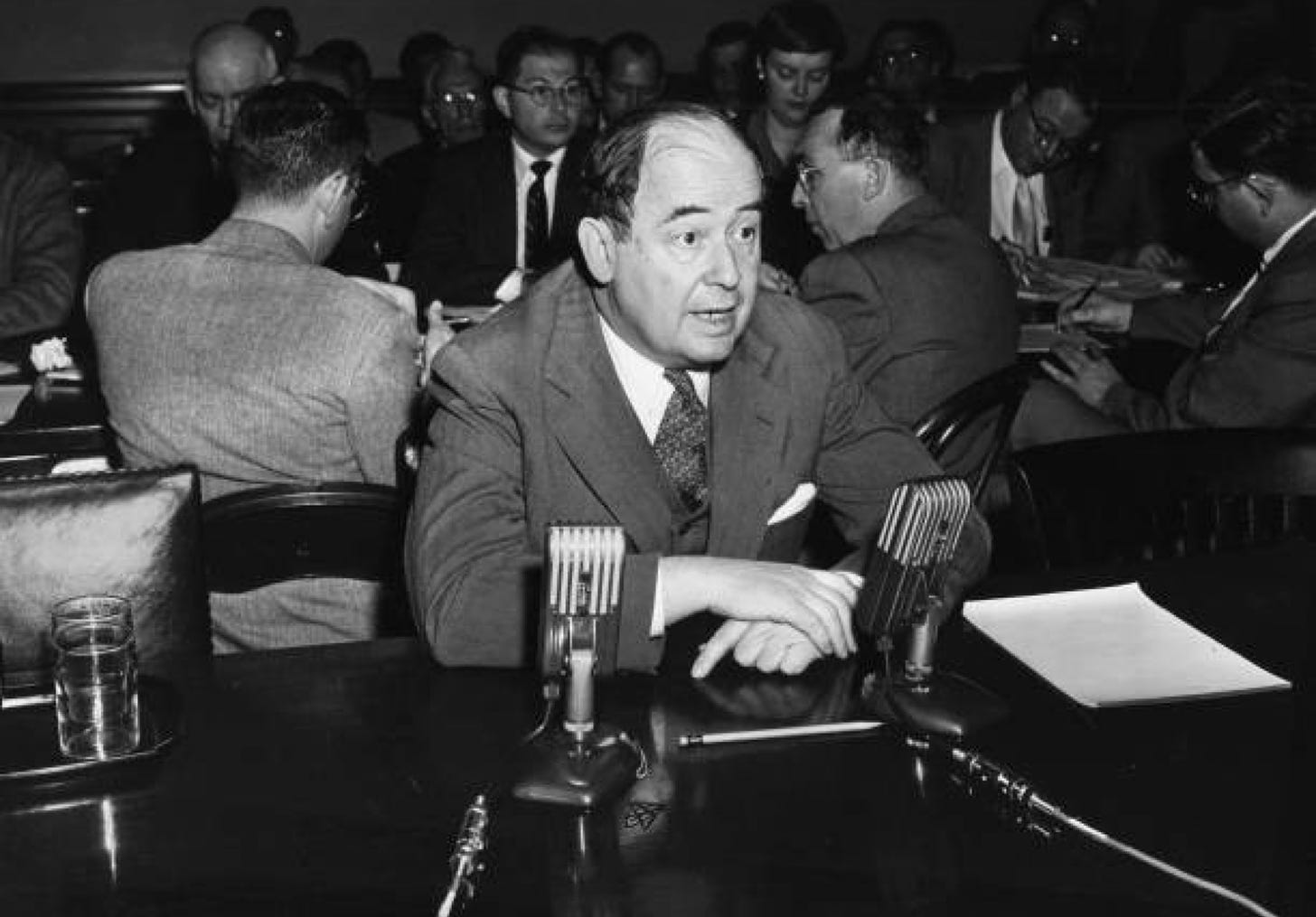
Throughout his career in America, von Neumann held a number of consultancies for various private, public and defense contractors including the National Defense Research Council (NDRC), the Weapons Systems Evaluation Group (WSEG), the Central Intelligence Agency (CIA), the Lawrence Livermore National Laboratory (LLNL) and the RAND Corporation, in addition to being an advisor to the Armed Forces Specials Weapons Project, a member of the General Advisory Committee of the Atomic Energy Commission, of the Scientific Advisory Group of the United States Air Force and in 1955 a commissioner of the Atomic Energy Commission (AEC).
Personality
Despite his many appointments, responsibilities and copious research output, von Neumann lived a rather unusual lifestyle for a mathematician. As described by Vonnauman and Halmos:
“Parties and nightlife held a special appeal for von Neumann. While teaching in Germany, von Neumann had been a denizen of the Cabaret-era Berlin nightlife circuit.” — Vonneuman (1987)
The parties at the von Neumann’s house were frequent, and famous, and long. — Halmos (1958)

His first wife, Klara, said that he could count everything except calories.
von Neumann also enjoyed Yiddish and dirty jokes, especially limericks (Halmos, 1958). He was a non-smoker, but at the IAS received complaints for regularly playing extremely loud German march music on the gramophone in his office, distracting those in neighboring offices, including Albert Einstein. In fact, von Neumann claimed to do some of his best work in noisy, chaotic environments such as in the living room of his house with the television blaring. Despite being a bad driver, he loved driving, often while reading books, leading to various arrests and accidents.

As a Thinker
Stanislaw Ulam, one of von Neumann’s close friends, described von Neumann’s mastery of mathematics as follows:
“Most mathematicians know one method. For example, Norbert Wiener had mastered Fourier transforms. Some mathematicians have mastered two methods and might really impress someone who knows only one of them. John von Neumann had mastered three methods: 1) A facility for the symbolic manipulation of linear operators, 2) An intuitive feeling for the logical structure of any new mathematical theory; and 3) An intuitive feeling for the combinatorial superstructure of new theories.”
Biographer Sylvia Nasar describes von Neumann’s own “thinking machine” by the following, now well-known anecdote regarding the so-called “two trains puzzle”:
Two bicyclists start twenty miles apart and head toward each other, each going at a steady rate of 10 m.p.h. At the same time, a fly that travels at a steady 15 m.p.h. starts from the front wheel of the southbound bicycle and flies to the front wheel of the northbound one, then turns around and flies to the front wheel of the southbound one again, and continues in this manner till he is crushed between the two front wheels. Question: what total distance did the fly cover?
There are two ways to answer the problem. One is to calculate the distance the fly covers on each leg of its trips between the two bicycles and finally sum the infinite series so obtained. The quick way is to observe that the bicycles meet exactly an hour after they start so that the fly had just an hour for his travels; the answer must therefore be 15 miles. When the question was put to von Neumann, he solved it in an instant, and thereby disappointed the questioner: “Oh, you must have heard the trick before!”
“What trick,” asked von Neumann, “all I did was sum the infinite series.”
—Excerpt, A Beautiful Mind (Nasar, 1998)
As a Supervisor
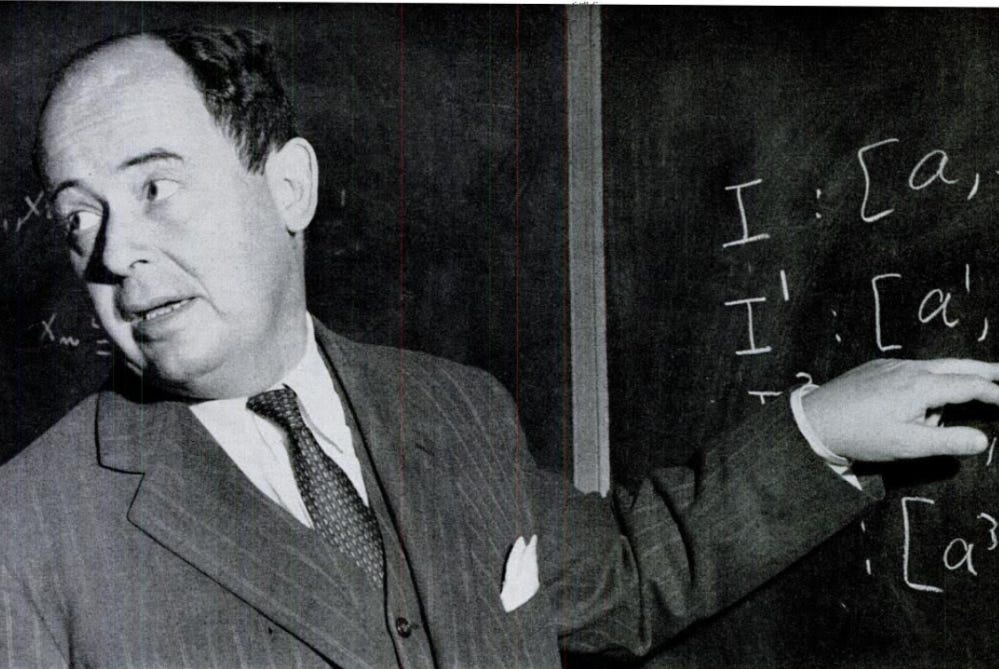
In the paper Szeged in 1934 (Lorch, 1993) Edgar R. Lorch describes his experience of working as an assistant for von Neumann in the 1930s, including his duties:
- Attending von Neumann’s lectures on operator theory, taking notes, completing unfinished proofs and circulating them to all American university libraries;
- Assisting von Neumann in his role as the editor of the Annals of Mathematics by reading through every manuscript accepted to the publication, underlining greek letters in red and german letters in green, circling italics, writing notes to printers in the margins and going once per week to the printers in order to instruct them in the art of typesetting;
- Translating von Neumann’s numerous 100-page papers into English;
"His fluid line of thought was difficult for those less gifted to follow. He was notorious for dashing out equations on a small portion of the available blackboard and erasing expressions before students could copy them."
—Excerpt, John von Neumann: As Seen by his Brother by N.A. Vonneuman (1987)
Later years
In 1955, Von Neumann was diagnosed with what was likely either bone, pancreatic or prostate cancer (accounts differ on which diagnosis was made first). He was 51 years old. Following two years of illness which at the end confined him to a wheelchair, he eventually died on the 8th of February 1957, at 53 years old. On his deathbed, he reportedly entertained his brother by reciting the first few lines of each page from Goethe’s Faust, word-for-word, by heart (Blair, 1957).
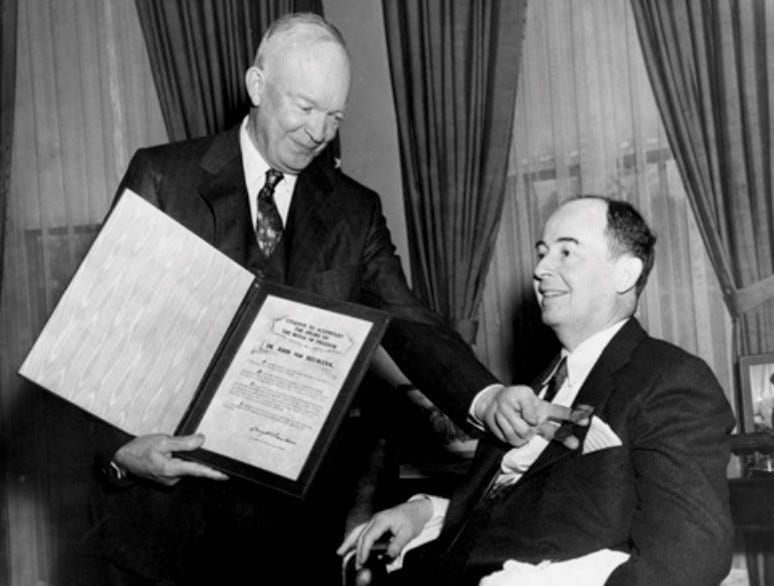
He is buried at Princeton Cemetery in Princeton, New Jersey alongside his lifelong friends Eugene Wigner and Kurt Gödel. Gödel wrote him a letter a year before his death, which has been made public. The letter is discussed in detail by Hartmanis (1989) in his working paper The Structural Complexity Column. An excerpt is included below:
Letter from Kurt Gödel to von Neumann, March 20th 1956
Dear Mr. von Neumann:
With the greatest sorrow I have learned of your illness. The news came to me as quite unexpected. Morgenstern already last summer told me of a bout of weakness you once had, but at that time he thought that this was not of any greater significance. As I hear, in the last months you have undergone a radical treatment and I am happy that this treatment was successful as desired, and that you are now doing better. I hope and wish for you that your condition will soon improve even more and that the newest medical discoveries, if possible, will lead to a complete recovery.
[...]
I would be very happy to hear something from you personally. Please let me know if there is something that I can do for you. With my best greetings and wishes, as well to your wife,
Sincerely yours,
Kurt Gödel
P.S. I heartily congratulate you on the award that the American government has given to you
Interview on Television
Remarkably, there exists a video interview with von Neumann on the NBC show America’s Youth Wants to Know in the early 1950s (below):
For anyone interested in learning more about the life and work of John von Neumann, I especially recommend his friend Stanislaw Ulam’s 1958 essay John von Neumann 1903–1957 in the Bulletin of the American Mathematical Society 64 (3) pp 1–49 and the book John von Neumann* by Norman Macrae (1992).
Sincerely,
Jørgen
References
- Blair, C. 1957. Passing of a Great Mind. Life Magazine. Feb. 25th. 1957.
- Fraenkel, S. 1972. Letter to to Brian Randell, 1972, quoted in Jack Copeland (2004) The Essential Turing, p. 22
- Henderson, H. 2007. Mathematics: Powerful Patterns Into Nature and Society*. New York: Chelsea House
- Leonard, R. 2010. Von Neumann, Morgenstern, and the Creation of Game Theory*. Cambridge University Press. pp. 42
- Macrae, N. 1992. John von Neumann: The Scientific Genius Who Pioneered the Modern Computer, Game Theory, Nuclear Deterrence, and Much More*. Pantheon Press.
- Nasar, S. 1998. A Beautiful Mind*. Simon & Schuster
- Petrovic, R. & Siljak, D. 1962. “Multiplication by means of coincidence”. ACTES Proc. of 3rd Int. Analog Comp. Meeting.
- Poundstone, W. 1992. Prisoner’s Dilemma: John von Neumann, Game Theory and the Puzzle of the Bomb*. Anchor Books.
- Regis, E. 1992. Johnny Jiggles the Planet. The New York Times, November 8th, 1992, Section 7, Page 12.
- Ulam, S. 1958. John von Neumann 1903–1957. The Bulletin of the American Mathematical Society 64 (3) pp 1–49.
- Van Hove, L. 1958. von Neumann’s Contributions to Quantum Theory. Bull. Amer. Math. Soc. 64 (3), pp. 95-99.
* Amazon affiliate links

